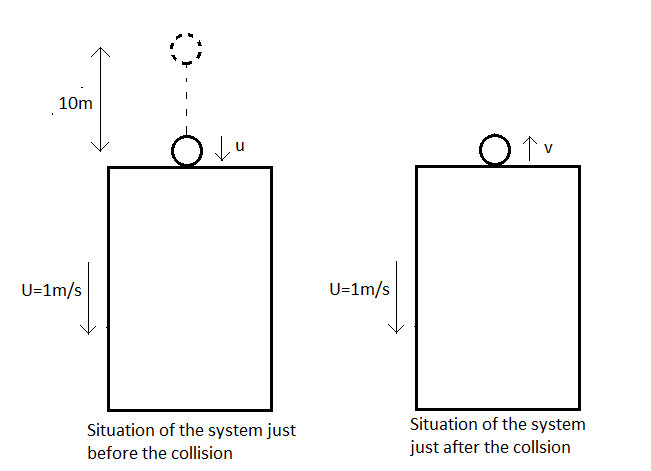
A ball after falling from a height of $10m$ strikes the roof of a lift which is descending down with a velocity of $1m/s$. The recoil velocity of the ball will be:-
$A)\,8m/s$
$B)\,11m/s$
$C)\,12m/s$
$D)\,15m/s$
Answer
571.8k+ views
Hint: This situation can be considered to be a perfectly elastic collision between a body one of whose masses is negligible in comparison to the other. If both the bodies were moving in the same direction before collision, the final speed of the lighter body will be its original speed minus double the original speed of the heavier body.
Formula used:
$v=\sqrt{2gh}$
Complete answer:
This is a situation of an elastic collision between a much heavier body (the lift) and the much lighter body (the ball). So, we can use the formula for the final speed of a lighter body after it collides with a much heavier object moving in the same direction.
The final speed $v$ of a lighter body after it collides elastically with a much heavier body moving with a speed $U$ in the same direction is given by
$v=u-2U$ --(1)
Where $u$ is the speed of the lighter body before the collision.
The speed $v$ attained by a body when it is dropped from a height $h$ is given by
$v=\sqrt{2gh}$ --(2)
Where $g=9.8m/{{s}^{2}}$ is the acceleration due to gravity.
Now, let us analyze the question.

The height from which the ball drops is $h=10m$.
Let the speed of the ball just before the collision be $u$.
Let the rebound speed of the ball after the collision be $v$.
The speed of the lift is $U=1m/s$.
Now, using (1), we get
$u=\sqrt{2\times 9.8\times 10}=\sqrt{196}=14m/s$ --(3)
Also, using (2), we get
$v=u-2U$
Putting (3) in the above equation, we get
$v=14-\left( 2\times 1 \right)=14-2=12m/s$
Hence, we have got the rebound speed of the ball as $12m/s$.
So, the correct answer is “Option C”.
Note:
Students must note that the direction of the motion, that is, the sign of the speed is imperative in solving such elastic collision problems mathematically. For example, if the lift was moving in the opposite direction of the original direction of motion of the ball, then the final rebound speed of the ball will be the sum of the original speed of the ball and twice the speed of the lift, that is, then the equation would then have been $v=u+2U$ and the change in the direction of motion is represented in the change of sign of $U$.
Formula used:
$v=\sqrt{2gh}$
Complete answer:
This is a situation of an elastic collision between a much heavier body (the lift) and the much lighter body (the ball). So, we can use the formula for the final speed of a lighter body after it collides with a much heavier object moving in the same direction.
The final speed $v$ of a lighter body after it collides elastically with a much heavier body moving with a speed $U$ in the same direction is given by
$v=u-2U$ --(1)
Where $u$ is the speed of the lighter body before the collision.
The speed $v$ attained by a body when it is dropped from a height $h$ is given by
$v=\sqrt{2gh}$ --(2)
Where $g=9.8m/{{s}^{2}}$ is the acceleration due to gravity.
Now, let us analyze the question.

The height from which the ball drops is $h=10m$.
Let the speed of the ball just before the collision be $u$.
Let the rebound speed of the ball after the collision be $v$.
The speed of the lift is $U=1m/s$.
Now, using (1), we get
$u=\sqrt{2\times 9.8\times 10}=\sqrt{196}=14m/s$ --(3)
Also, using (2), we get
$v=u-2U$
Putting (3) in the above equation, we get
$v=14-\left( 2\times 1 \right)=14-2=12m/s$
Hence, we have got the rebound speed of the ball as $12m/s$.
So, the correct answer is “Option C”.
Note:
Students must note that the direction of the motion, that is, the sign of the speed is imperative in solving such elastic collision problems mathematically. For example, if the lift was moving in the opposite direction of the original direction of motion of the ball, then the final rebound speed of the ball will be the sum of the original speed of the ball and twice the speed of the lift, that is, then the equation would then have been $v=u+2U$ and the change in the direction of motion is represented in the change of sign of $U$.
Recently Updated Pages
Master Class 11 Economics: Engaging Questions & Answers for Success

Master Class 11 English: Engaging Questions & Answers for Success

Master Class 11 Social Science: Engaging Questions & Answers for Success

Master Class 11 Biology: Engaging Questions & Answers for Success

Class 11 Question and Answer - Your Ultimate Solutions Guide

Master Class 11 Business Studies: Engaging Questions & Answers for Success

Trending doubts
What is meant by exothermic and endothermic reactions class 11 chemistry CBSE

10 examples of friction in our daily life

One Metric ton is equal to kg A 10000 B 1000 C 100 class 11 physics CBSE

Difference Between Prokaryotic Cells and Eukaryotic Cells

What are Quantum numbers Explain the quantum number class 11 chemistry CBSE

1 Quintal is equal to a 110 kg b 10 kg c 100kg d 1000 class 11 physics CBSE




